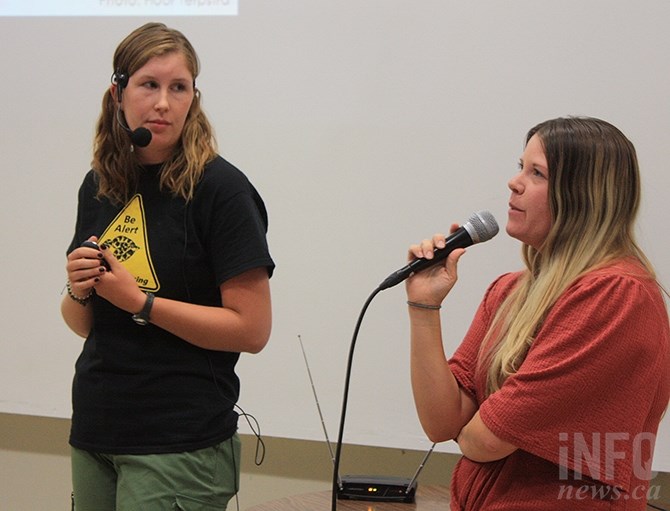
Two Thompson Rivers University researchers who have discovered some interesting facts about the region's Western rattlesnake presented their summer's findings in a noon hour lecture at the Penticton library this afternoon, Oct. 1, 2019.
(STEVE ARSTAD / iNFOnews.ca)
October 03, 2019 - 6:00 AM
PENTICTON - A couple of Thompson Rivers University researchers are constantly on the road studying what’s killing local snake populations. And when we say they are on the road — they are literally on the road.
Jade Spruyt and Dana Eye are researching the Okanagan’s Western Rattlesnake at Inkameep Desert Cultural Centre and in the White Lake Basin southwest of Penticton. This past summer they studied female rattlesnake breeding habits and mortality rates of rattlesnakes along White Lake and Willowbrook Roads in the South Okanagan.
Spruyt said she discovered a surprising and disturbing mortality rate on Okanagan backroads.
Using research results from a previous study, and results of daily tracking of 12 km of the area roadside, she counted 141 deaths last summer. That number amounts to roughly 6.6 per cent of the snake population in the White Lake basin being killed on the area’s two roads.
“If that rate of mortality were to increase even a little, we could be looking at extinction of rattlesnakes in the area within 100 years,” she told a small assembly of Penticton residents this week.
Spruyt was able to pinpoint “hot spots” along the road where the majority of deaths occurred, undertaking mitigation efforts that included erection of snake fencing and installation of culverts under the road to provide snake passageways.
Her research will continue next summer to assess the effectiveness of those efforts.

Rattlesnake researchers Jade Spruyt and Dana Eye.
(STEVE ARSTAD / iNFOnews.ca)
Eye’s research focused on habits of pregnant snakes, using telemetry to track the snake’s movements over the summer.
She found some odd behaviour in the females, who would migrate relatively long distances from their rookery sites after giving birth, initial research suggesting the snakes were moving in order to find food and water after the arduous process of giving birth.
Eye’s research also discovered commonalities in birthing sites. The four birthing sites discovered were all secluded under rocks, and surrounded by shrubs and other cover.
Her research next year will include tracking of non-pregnant females.
The rattlesnake’s range in B.C. includes all of the Okanagan and into the Thompson valley just north of Kamloops, one of seven native snake species native to the province.
Other snakes include the Western yellow billed racer, the western garter snake, the rubber boa, the common garter snake, the night snake and the Great Basin gopher snake, often referred to as a bull snake.
To contact a reporter for this story, email Steve Arstad or call 250-488-3065 or email the editor. You can also submit photos, videos or news tips to: tips@infonews.ca nd be entered to win a monthly prize draw.
We welcome your comments and opinions on our stories but play nice. We won't censor or delete comments unless they contain off-topic statements or links, unnecessary vulgarity, false facts, spam or obviously fake profiles. If you have any concerns about what you see in comments, email the editor in the link above.
News from © iNFOnews, 2019